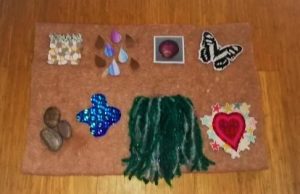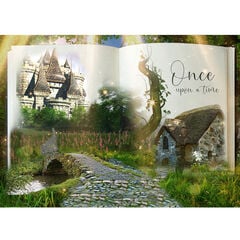The oral tradition of storytelling has been around a long time and spans many different cultures from around the world.
Those in the community who were the designated storytellers were also often seen as healers and teachers. They used a variety of methods to assist and illustrate their tales, including artwork, chants, shared songs, and dances. Even after the invention of writing, storytelling has still formed an important part of life. Small children use toys to create or retell known tales.
(If you are interested in finding out more about how and why we create stories, Will Storr’s “The Science of Storytelling” is a fascinating read.)

The many benefits …
In the retelling of a story, it becomes the recreation of the teller. There does not have to be a “blueprint” set in stone for the story. It can evolve, adapting to the needs or interests of the teller and the listeners. The fact that it does not need to involve handwriting or typing, spelling or punctuation, can be liberating, and boost creativity.
There are many different resources and activities that can be used to support Storytelling in different ways. Here are just a few:
Storytelling dice or cards
- These can be easily made or purchased. They can be used to tell mini-stories or create a context for a story e.g., character/setting/object/activity, and can be extended to include different word classes. At its most basic form, the card version involves dealing out one card from each pile, then each player makes up a mini-story from their “hand” – often quite hilarious. For example, recently a 6-year-old I was playing this game with made up, “The cat was skipping angrily on the bus because he ate a strawberry.” He could not stop giggling and was keen to share his story with others!
Story Maps
- Creating an illustrated Story Map is a wonderful way to help remember the “journey” of a story. It can help with retelling a known story or one that has been created from scratch. Story Maps can also provide the inspiration for creating a story, based on the landmarks/characters/features they include. Treasure Island maps are a fitting example of this as they encourage children to explore the “quest adventure” genre.
Festivals and Celebrations
- One school I worked at chose storytelling as a focus for the annual Art and Writing Festival. We had a variety of storytellers visit the school and work with the different age groups. Children listened to stories and then the storytellers shared some of their tips for storytelling. Children were able to practise different techniques involved. Each class then worked on creating stories to tell and crafting props to assist and illustrate the retelling.
- I chose to use a painting to inspire the children’s imagination:

N.C. Wyeth’s “The Giant”
The following is an explanation of the types of activities we undertook during the project:
- I shared the picture on the IWB, but initially using the “Screen Shade” tool to block off the giant, leaving just the children visible in the scene. Pupils worked in groups to recreate the pose and explored what they thought was occurring in the beach scene. I had objects available including shells, sand, driftwood, pebbles, “mermaid glass,” as well as sound and film clips to help with this as some pupils had not had the opportunity to visit the beach.
- I then slowly revealed what the children in the painting were looking at. We used roleplay to explore what the children might be saying to each other. We also asked questions like: What is the giant doing? Where has he been? Where is he going? We had a “lucky dip” for each group which identified a mood/adjective for their giant: happy, sad, angry, kind etc and pupils suggested reasons why the giant may be behaving in this way and what the result of this could be.
- The pupils then worked in their groups to create a story about the children and the giant. They started with the children enjoying themselves, the arrival of the giant, what happened next and how the story was resolved. The groups considered a range of techniques to use during their retelling, including sounds, choral chants, different narrative voices, gestures/movements, etc. We also enlisted the support of the school’s Teachers of the Deaf to incorporate some signing within the performances.
- Once the groups had agreed on a storyline, they were given plenty of time to rehearse and refine the performance of the tale.
Top tip
Story tents are a fantastic way to create a special space for storytelling. Simply drape sheets/fabric over furniture/PE apparatus and furnish with some cushions. Some classes also made tactile rugs for their audience to hold onto while listening to the stories.
- We decided to create a tipi-style story tent using a wicker framework. Each group decided on some objects/ideas from their story and used fabric and sewing skills to make representations. We fixed these onto hessian panels around the outside of the tipi.

- At the end of the festival, each group told their story to pupils from other year groups.
The storytellers and the audiences really enjoyed the experience, and it was fascinating to see how each group’s storytelling developed as their confidence grew. They were able to use more intonation, volume, and gestures, invite audience participation and engage their listeners.
With many thanks to Jayne Gilbert for sharing her ideas in this blog.
My name is Jayne and I have been a teacher for around 34 years. 23 of these were spent working as a class teacher in two primary schools in South-East London where I also had the additional responsibility for Literacy and/or Art. This wasn’t really unexpected as my mum was also a teacher and for as long as I can remember, she fostered in me a love of books and reading, art and craft. Since leaving class teaching, I have worked in an office, as a labourer on a construction site, and back in an office for a short while. Recently, I have rediscovered my love of writing and this has been put to good use volunteering for the e-commerce department of my local hospice shop, creating descriptions for advertising items.
I hope you enjoy reading about my ideas and trying out the activity suggestions!




